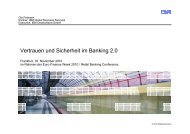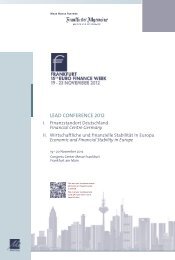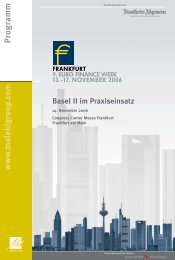The Two European Hydrological Cycles:
The Two European Hydrological Cycles:
The Two European Hydrological Cycles:
Create successful ePaper yourself
Turn your PDF publications into a flip-book with our unique Google optimized e-Paper software.
closing of the first loop).<br />
A "second critical threshold" can then be crossed in the second feedback loop during<br />
intense Mediterranean cyclogenesis events, when torrential rains trigger mud flows over the<br />
drier and vegetation-deprived mountain slopes already affected by the first feedback loop.<br />
This can result in massive soil losses and a further reinforcement, and propagation of the<br />
effects caused by the first feedback loop, etc. Available evidence not only indicates that<br />
these processes and feedbacks have been operating in the Mediterranean for a long time,<br />
but also suggests that fundamental changes, and long-term perturbations to the <strong>European</strong><br />
water-cycle (droughts and floods), are taking place right now.<br />
This analysis further suggests that: up to 75% (or more) of the precipitation in southern<br />
Europe, i.e., from Summer storms and Mediterranean Cyclogenesis, originates from water<br />
that first evaporates and then precipitates, i.e., it is recirculated, within the major<br />
Mediterranean drainage basin (i.e., all the areas south and east of the <strong>European</strong> Continental<br />
Divide including the Mediterranean and Black seas, Slides 25 and 27). Moreover, on the<br />
Mediterranean side of this divide, rain of Atlantic origin contributes less than � 20% of the<br />
total (probably even less than that in Greece), in stark contrast with the Atlantic side of the<br />
<strong>European</strong> Divide where � 80% or more of the precipitation is from water evaporated over the<br />
Atlantic (Slides 28-29).<br />
Finally, land-use appears to play a key role in the loss of summer storms, the shift to more<br />
frequent vertical recirculation periods, and the amount of water recirculated within the basin.<br />
<strong>The</strong>se findings and the questions they raise are critical for <strong>European</strong> Union water policies in<br />
Southern Europe because:<br />
(a) water from precipitation tends to be treated as a given resource without duly<br />
considering its origins,<br />
(b) disaggregation of precipitation components is not normally performed in climatic<br />
studies and,<br />
(c) the feedback processes in the hydrological cycle, which govern the partitioning and<br />
the recycling of the precipitation in each region, cannot be simulated in the Global<br />
Models used to assess future water scenarios for Europe.<br />
Thus, the decisions on the future of the water cycle, and particularly the timing of such<br />
decisions, could be absolutely wrong and have catastrophic consequences for Southern<br />
Europe. This work presents a summary of the evidence we use to support this statement<br />
(Slide 31).
















